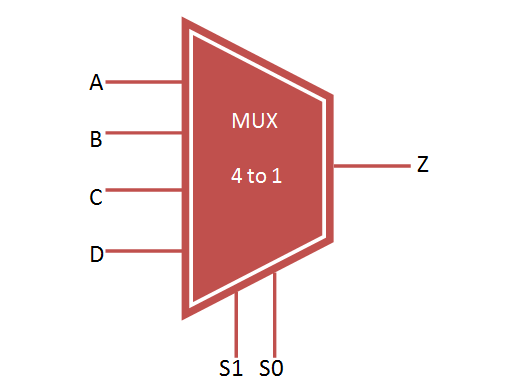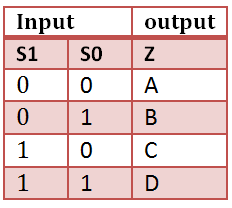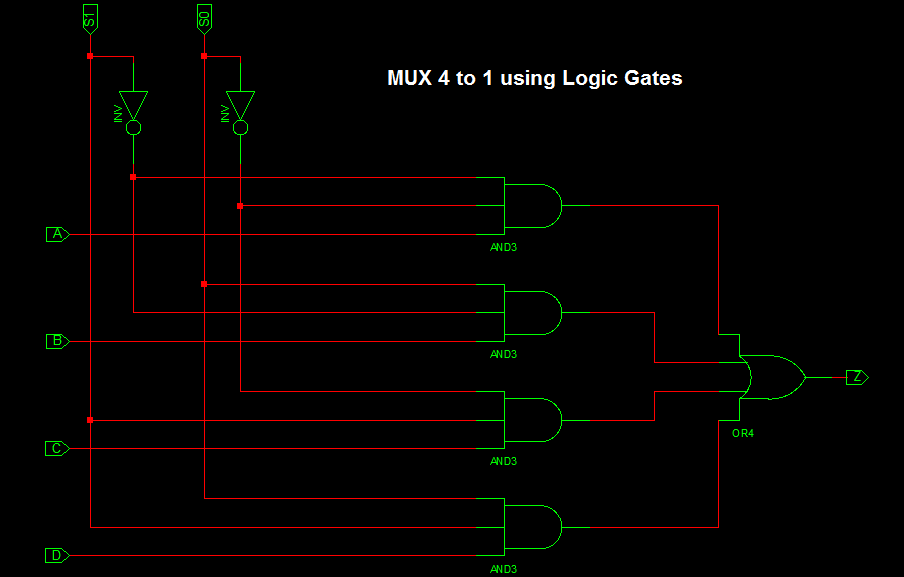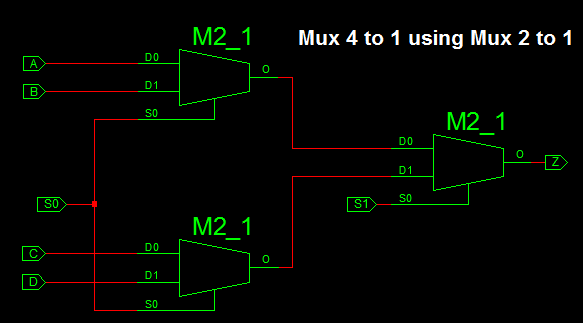Table of Contents
Multiplexer
Multiplexer (MUX) select one input from the multiple inputs and forwarded to output line through selection line. It consist of 2 power n input and 1 output. The input data lines are controlled by n selection lines.
For Example, if n = 2 then the mux will be of 4 to 1 mux with 4 input, 2 selection line and 1 output as shown below.
Truth Table for Multiplexer 4 to 1
Mux 4 to 1 design using Logic Gates
VHDL Code For 4 to 1 Multiplexer
library IEEE;
use IEEE.STD_LOGIC_1164.all;
entity mux_4to1 is
port(
A,B,C,D : in STD_LOGIC;
S0,S1: in STD_LOGIC;
Z: out STD_LOGIC
);
end mux_4to1;
architecture bhv of mux_4to1 is
begin
process (A,B,C,D,S0,S1) is
begin
if (S0 ='0' and S1 = '0') then
Z <= A;
elsif (S0 ='1' and S1 = '0') then
Z <= B;
elsif (S0 ='0' and S1 = '1') then
Z <= C;
else
Z <= D;
end if;
end process;
end bhv;
VHDL TestBench Code for 4 to 1 Multiplexer
LIBRARY ieee;
USE ieee.std_logic_1164.ALL;
ENTITY tb_mux IS
END tb_mux;
ARCHITECTURE behavior OF tb_mux IS
-- Component Declaration for the Unit Under Test (UUT)
COMPONENT mux_4to1
PORT(
A : IN std_logic;
B : IN std_logic;
C : IN std_logic;
D : IN std_logic;
S0 : IN std_logic;
S1 : IN std_logic;
Z : OUT std_logic
);
END COMPONENT;
--Inputs
signal A : std_logic := '0';
signal B : std_logic := '0';
signal C : std_logic := '0';
signal D : std_logic := '0';
signal S0 : std_logic := '0';
signal S1 : std_logic := '0';
--Outputs
signal Z : std_logic;
BEGIN
-- Instantiate the Unit Under Test (UUT)
uut: mux_4to1 PORT MAP (
A => A,
B => B,
C => C,
D => D,
S0 => S0,
S1 => S1,
Z => Z
);
-- Stimulus process
stim_proc: process
begin
-- hold reset state for 100 ns.
wait for 100 ns;
A <= '1';
B <= '0';
C <= '1';
D <= '0';
S0 <= '0'; S1 <= '0';
wait for 100 ns;
S0 <= '1'; S1 <= '0';
wait for 100 ns;
S0 <= '0'; S1 <= '1';
wait for 100 ns;
S0 <= '0'; S1 <= '1';
wait for 100 ns;
end process;
END;
Output Waveform for 4 to 1 Multiplexer
Another Method of Constructing VHDL 4 to 1 mux is by using 2 to 1 Mux. For that implementation first we have write VHDL Code for 2 to 1 Mux and Port map 3 times 2 to 1 mux to construct VHDL 4 to 1 Mux.
4 to 1 Mux Implementation using 2 to 1 Mux
VHDL Code for 2 to 1 Mux
library IEEE; use IEEE.STD_LOGIC_1164.ALL; entity mux2_1 is port(A,B : in STD_LOGIC; S: in STD_LOGIC; Z: out STD_LOGIC); end mux2_1; architecture Behavioral of mux2_1 is begin process (A,B,S) is begin if (S ='0') then Z <= A; else Z <= B; end if; end process; end Behavioral;
VHDL 4 to 1 Mux using 2 to 1 Mux
library IEEE; use IEEE.STD_LOGIC_1164.ALL; entity mux4_1 is port( A,B,C,D : in STD_LOGIC; S0,S1: in STD_LOGIC; Z: out STD_LOGIC ); end mux4_1; architecture Behavioral of mux4_1 is component mux2_1 port( A,B : in STD_LOGIC; S: in STD_LOGIC; Z: out STD_LOGIC); end component; signal temp1, temp2: std_logic; begin m1: mux2_1 port map(A,B,S0,temp1); m2: mux2_1 port map(C,D,S0,temp2); m3: mux2_1 port map(temp1,temp2,S1,Z); end Behavioral;
VHDL Testbench and Simulation Waveform for 4 to 1 mux using 2 to 1 mux is same as the above implementation.







very good explanation, thank you!